Winter Audio Reference: On-Board, Consumer, and Pro Solutions
by Derek Wilson on February 3, 2005 12:05 AM EST- Posted in
- Smartphones
- Mobile
Gaming Performance Tests
As game frame rates in modern systems are not heavily impacted by various audio settings, one of the best measures of "goodness" for games will be simply the maximum number and type of hardware buffers that the card supports. Beyond that, the RightMark 3DSound synthetic test can give an indication of what CPU usage will be like in gaming situations. Listed below are the number and type of hardware buffers that each card supports:
Intel HD Audio: 32 buffers 2D, 3D, EAX 2
Gina3G: 128 buffers 2D only
SoundBlaster Audigy 2 ZS PPro: 62 buffers 2D, 3D, EAX 4 Advanced HD
SoundBlaster Audigy 4 Pro: 62 buffers 2D, 3D, EAX 4 Advanced HD
The fact that the Gina3G can open over twice as many DirectSound buffers as the Audigy gives it an advantage in its ability to push audio. But the target is definitely more of a home studio multi-track editing environment rather than a gaming environment. The Gina3G's lack of any 3D accelerated buffer support does make it less of a gaming audio card, as is to be expected. While the Realtek Intel solution provides EAX 2, it's able to provide adequate support for most games on the market.
There are titles out with support for EAX 3 and 4, and they do sound good. Games like Thief 3 and The Chronicles of Riddick make good use of audio to help the gamer actually play the game. Understanding an environment is becoming truly necessary in modern gaming. But we would prefer to see unique personal innovation or the adoption of open standards rather than consumption of proprietary technology.
The RightMark test simulates some normal positional audio effects and internally checks CPU usage every half second. Overall, CPU usage is averaged together at the end of the run. This is the number that we will look at here. Our graphs are broken into multiple series for 16 and 32 buffers, and we've done graphs for the "no audio" case, simple stereo, hardware 3D, and hardware 3D + EAX. Positional audio, in this case, is done via DirectX.
In our tests, we see the Audigy 2 outperforming the Audigy 4 in our DS3D and EAX tests. The Intel solution puts in a good showing as well, though Creative naturally does EAX better. In the 2D realm, the Gina3G doesn't do too poorly either. Note also, that we are talking about percent CPU usage here, so a score of 0.1 is 0.1% of the CPU. The heaviest hitting test comes in at under 5% CPU usage, which just goes to show how little impact even our least efficient HW 3D + EAX implementation has on overall game performance.
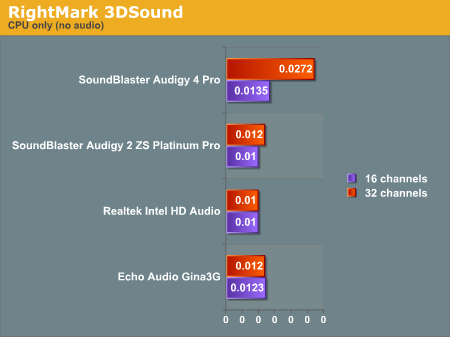
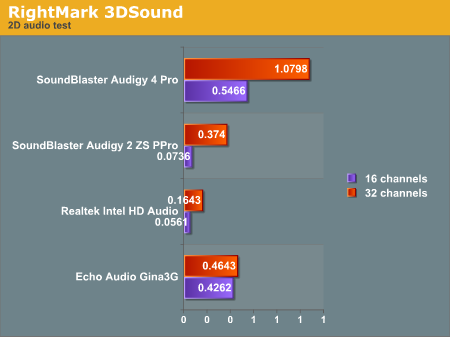
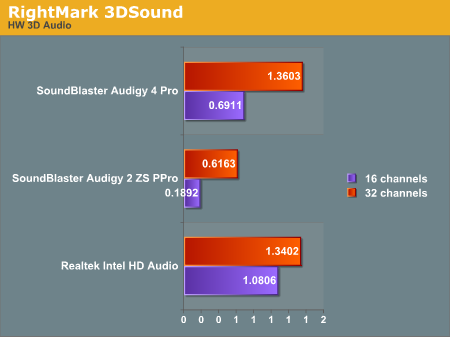
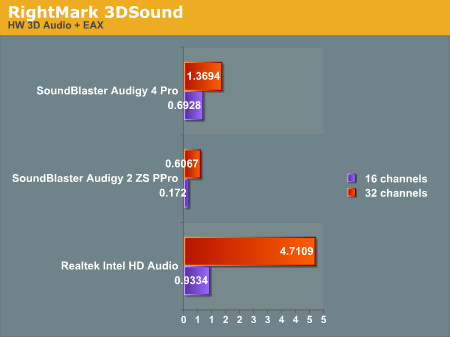
To round out our gaming performance analysis, we'll take a look at Unreal Tournament 2004. All the in-game graphics details were set to "normal" and resolution was set to 800x600. Higher settings pushed the rest of the system too high and drowned out the effect of the audio (as the graphics card became the limiting factor rather than the CPU). Call this artificial if you like, but showing that it takes this much to get a performance delta out of enabling audio is a useful test in and of itself. Especially considering the fact that these differences are bigger than what we saw with Doom 3 no matter what we did.
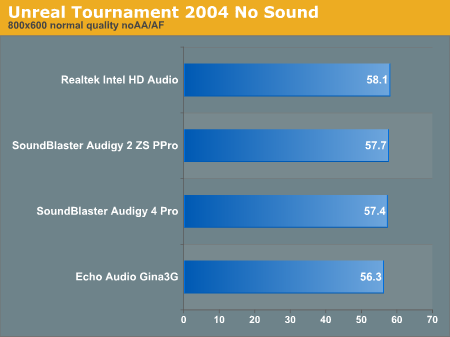
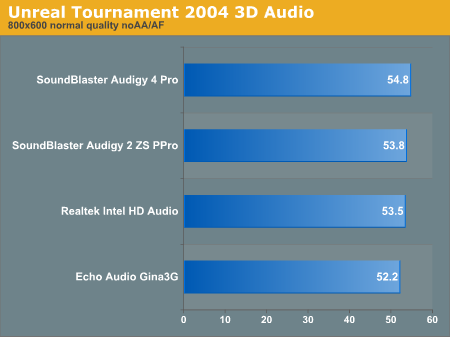
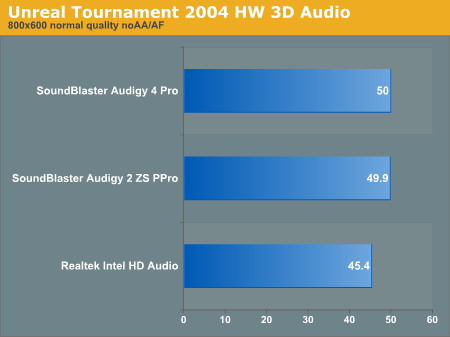











89 Comments
View All Comments
smn198 - Thursday, February 3, 2005 - link
For me personally what I would want is reviews of gaming perfomance since I used the SPDIF outputs and my HiFi so they all should so the same. I'd also like to know how much difference there really is between different EAX implementations and if it is true that a new SoundStorm board is coming out. I'm sure you know. Can't you just claim you forgot the NDA? ;)reidc - Thursday, February 3, 2005 - link
My main reason for a soundcard is transferring analog audio from my Turntable(remember those 12" pieces of vinyl????) to CD- or commonly referred to as "needle-drops". The higher quality DAC's and discrete components the better.When I went from my old SB-Live to turtle Beach Santa Cruz- I recevied a huge boost in quality- the drop in noise was huge.
I'd love to see how the TB SC holds up in this regard compared to the listed products.
Oh- my TB SC is currently not in a PC- as I am just getting the Intel 915 board running in a mchine. I assume by seeing the Intel HD Audio tests- I WILL be putting my Santa Cruz in.
Chris
sandorski - Thursday, February 3, 2005 - link
Yup, a wider range of cards would be nice.ottodostal - Thursday, February 3, 2005 - link
I am quit disappointed with this review as there are only so few audio cards there. There are so many of them on the market! You must definitely include M-Audio Revolution 7.1, and some card from Audiotrak Maya + Prodigy series (aka Prodigy 7.1), and Aureon 7.1 Universe or DMX 6fire from Terratec. These are of the major cards on the market and there are missing. You could also include Turtle Beach Santa Cruz, and some card from Hercules.I would also include more mid-range and maybe some even some high-en cards (like those from Aardvark or R M E or MOTU ) generally, do not concentrate on low-end cards like Audigy 2 from Creative. In graphic cards reviews you expect us to pay over 600USD for them, so why to concentrate on value cards in audio tests? BTW if you think that people are not doing such things like playing games on audio cards which cost over 800USD you are wrong :)
You should also include some external USB and Firewire cards like Audiophile USB or FireWire 410 from M-Audio (one of my friends recently brought the Audiophile USB replacing some older Audiotrak Maya and he is quit happy with it. He told that even listening to mp3 files is clearly better).
You must also include latency tests in the review and you should comment on support of main standards lide ASIO and GSIF.
DerekWilson - Thursday, February 3, 2005 - link
#13, ceefka,if you're refering to not calling Intel HD audio, it can do 24-bit/96kHz ... It just can't record at that bit rate. Playback is no problem. Of course, it's not as high quality as we would expect to see from that many bits per sample at that sampling rate.
#12, S0me1X,
The gina3g uses an external DAC/ADC which is one of the reasons we see a cleaner signal. Of course, the soundblaster uses a /better/ DAC, so we see lower noise and dynamic range even though the signal looks a lil shaky at spots.
external DACs are a very good idea.
Derek Wilson
ceefka - Thursday, February 3, 2005 - link
Any chance for one of the Terratec soundcards? I heard they're pretty good.My ideal soundcard or onboard solution should be
-96KHz/24-bit DTS/Dobly Surround and any previous standard
-optical and coaxial s/pdif input and output
-perhaps an analogue breakoutbox for simple stereo operation and additional analogue outputs.
With so many DVD-players around (even in cars), there is no need to stay in the 44.1/16 realm. 48/24 already sounds so much better than 44.1/16.
It would be nice to have onboards being taken more seriously by the manufacturers. The leads on a mobo are all quite exposed to everything else going on in there. A few efforts in shielding would probably make a real difference, even without changing the chip. I am not ready to pay for a crappy onboard solution. And don't call it HD unless it can do 96/24.
S0me1X - Thursday, February 3, 2005 - link
Best way to get quality sound out of a pc is to use an external DAC. I'm using a Benchmark DAC1 that I'm very happy with :)SignalPST - Thursday, February 3, 2005 - link
I just hope that Creative would fix the 44.1kHz resampling issue and IMD problems with the Sound Blaster Zenith sound cards thats suppose to come out sometime this year.sxr7171 - Thursday, February 3, 2005 - link
I don't see how the Audigy 4 is so much better than the Audigy 2 to recommend it over the Audigy 2. They are pretty much the same with the Audigy showing weaknesses and one strength in 24/96 D/A conversion. I guess internal computer audio is still not to be taken very seriously except for games (which the reviews sort of hints at).wrecktangle - Thursday, February 3, 2005 - link
any chance you could take a look at the m-audio revo 5.1? i've been looking for a review of this card for a long time. even a short update/comparison to the revo 7.1 would be great.on the whole, this review seems alright. kinda short though. definitely touch on recording quality in the future. maybe you could also stretch out the qualitative bit with some more music listening tests of other genres.
is it just me, or are the spectrum plots missing?